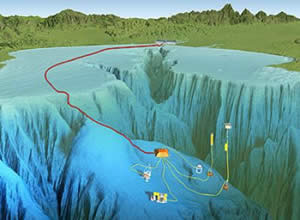
The Monterey Accelerated Research System (MARS) will allow scientists to perform long-term and real-time experiments. Credit: David Fierstein
Researchers completed an important step in constructing the first deep-sea cabled observatory in the continental United States. In a multi-institution effort managed by the Monterey Bay Aquarium Research Institute (MBARI) and funded by the National Science Foundation, 52 kilometers (32 miles) of cable were laid along the seafloor of Monterey Bay. This undersea cable will provide electrical power to scientific instruments, video cameras, and robots 900 meters (3,000 feet) below the ocean surface. The cable will also carry data from these instruments back to shore, for use by scientists and engineers around the world.
This cable is a key part of the Monterey Accelerated Research System (MARS) observatory. When completed later this year, MARS will provide ocean scientists with 24-hour-a-day access to instruments and experiments in the deep sea. Instead of using submarines to carry researchers into the deep, the MARS observatory will use the latest computer and internet technology to bring information about the deep sea directly to researchers' computers on shore.
Slightly thicker than a garden hose, the MARS cable is buried about three feet below the seafloor along most of its route, so that it will not be disturbed by boat anchors or fishing gear. The cable itself contains a copper electrical conductor and strands of optical fiber. The copper conductor will transmit up to 10 kilowatts of power from a shore station at Moss Landing, California, to instruments on the seafloor. The optical fiber will carry up to two gigabits per second of data from these instruments back to researchers on shore. This will allow scientists to monitor and control their instruments 24 hours a day, and to get an unique view of how environmental conditions in the deep sea change over time.
Currently, almost all oceanographic instruments in the deep sea rely on batteries for power and store their data on hard disks or memory chips until they are brought back to the surface. With a continuous and uninterrupted power supply, instruments attached to the MARS observatory could remain on the seafloor for months or even years. If anything goes wrong with these instruments, scientists will know immediately, and will be able to recover or reprogram them as necessary. This will allow ocean engineers to develop entirely new types of deep-sea instruments, undersea robots, and environmental monitoring systems.
At the seaward end of the MARS cable is a large steel frame about 1.2 meters (4 feet) tall and 4.6 meters (15 feet) on each side. This "trawl-resistant frame" will protect the electronic "guts" of the MARS observatory, which will serve as a computer network hub and electrical substation in the deep sea. The researchers hope to install these electronic components into the trawl-resistant frame in fall 2007.
After the electronics package is installed and tested, scientists from around the world will be able to attach their instruments to the observatory using underwater extension cords. These instruments will be carried down from the surface and plugged into the science node using MBARI's remotely operated vehicles (tethered robot submarines).
In addition to supporting oceanographic research within Monterey Bay, MARS will serve as a testing ground for technology that will be used on even more ambitious deep-sea observatories. Such observatories will use thousands of kilometers of undersea cables to hook up dozens of seismographs and oceanographic monitoring stations. They will provide scientists with new views of seafloor life as well as a new understanding of the global tectonic processes that spawn earthquakes and tsunamis.
The MARS project was initiated in 2002 through $8 million in grants from the National Science Foundation (NSF) coupled with $1.75 million in funds from the David and Lucile Packard Foundation. The NSF also contributed an additional $2 million to meet permitting and homeland security requirements. Components for the observatory are being designed and built by MBARI, the University of Washington, Woods Hole Oceanographic Institution, Nautronics Maripro, and Alcatel.
Reflecting on the effort that went into this installation, MBARI's president and CEO Marcia McNutt comments, "After five years of hard work, MBARI is thrilled to bring the age of the internet to the deep ocean, so that we can understand, appreciate, and protect the two thirds of the planet that lies under the sea. We are grateful for the help of our talented partners and our visionary sponsors. MARS has truly been a team effort."
